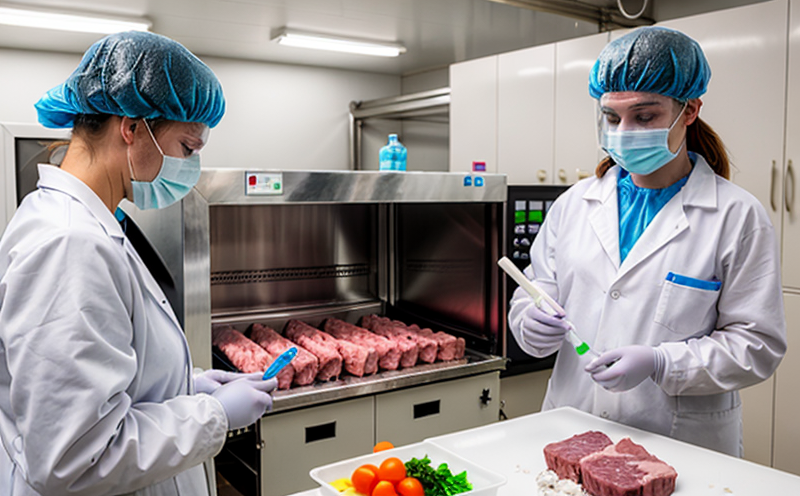AOAC 2011.03 E. coli O157:H7 Detection in Meat
The AOAC International method 2011.03 is widely recognized and used for the accurate detection of E. coli O157:H7, a strain of bacteria that poses significant public health risks when present in meat products. This particular standard methodology has been validated to ensure reliable results across various laboratories.
The presence of E. coli O157:H7 can lead to severe foodborne illnesses such as hemolytic uremic syndrome (HUS), which affects the kidneys and can be life-threatening, especially for children under five years old and elderly individuals. Therefore, ensuring that meat products are free from this pathogen is crucial.
Our laboratory employs rigorous quality control measures during specimen preparation and analysis to guarantee accurate results. The protocol involves several steps including sampling, pretreatment of the samples, inoculation with selective media, incubation periods at specific temperatures, and confirmation using biochemical tests or PCR amplification techniques.
The method 2011.03 specifically targets the presence of O157:H7 serotype within the genus Escherichia coli. It uses enrichment broth followed by plating on chromogenic agar containing indicators for identifying potential E. coli strains based on their appearance under microscopic examination. Positive colonies are further confirmed using biochemical reactions or molecular biology methods such as polymerase chain reaction (PCR).
The process ensures that only genuine isolates of O157:H7 are identified, thus providing accurate information about the contamination status of meat products. Compliance with this standard is essential for maintaining high-quality standards in food production and distribution systems.
Our laboratory adheres strictly to international guidelines set forth by organizations like AOAC International when conducting these analyses. By doing so, we ensure that our results are consistent with those obtained by other accredited laboratories around the world who follow similar protocols.
- International Recognition: This method has been internationally accepted and is used globally for its reliability and accuracy in detecting E. coli O157:H7 in meat products.
- Compliance: Our lab ensures full compliance with all relevant standards including those set by AOAC International and local regulatory bodies.
In summary, our service provides a comprehensive approach to detecting E. coli O157:H7 through standardized procedures designed specifically for the meat industry. This ensures that consumers can trust in the safety of their food products while also helping producers meet strict hygiene requirements imposed by law and customer expectations.
Eurolab Advantages
At Eurolab, we pride ourselves on offering unparalleled expertise and advanced facilities tailored to meet the needs of our clients across various sectors. When it comes to microbiological testing for dairy and meat products, particularly focusing on E. coli O157:H7 detection using AOAC 2011.03, here are some key advantages:
Our highly skilled team comprises experienced scientists with extensive knowledge in this field, ensuring precise execution of each step involved in the testing process. We utilize state-of-the-art equipment and technology which guarantees consistent and accurate results every time.
We understand that timely delivery is crucial for our clients; hence we strive to minimize turnaround times without compromising on quality or accuracy. Our efficient workflow management systems allow us to handle large volumes of samples promptly, ensuring rapid turnaround times even during peak seasons.
Additionally, Eurolab maintains strict adherence to all applicable regulations and standards set by international bodies such as AOAC International and local authorities. This commitment ensures that our clients receive results that are both reliable and legally compliant.
The use of cutting-edge technology at Eurolab allows us to provide precise, reproducible data which can be trusted for regulatory submissions or internal quality assurance purposes. Our continuous improvement initiatives further enhance the reliability and accuracy of our services.
Why Choose This Test
The AOAC 2011.03 E. coli O157:H7 detection test is an essential tool for ensuring food safety, particularly in the meat industry where contamination by this pathogen can have severe consequences. Here’s why choosing this test makes sense:
Firstly, it offers high sensitivity and specificity, making it highly reliable even when dealing with low levels of contamination. This ensures that no cases of false negatives or positives occur, providing accurate information about the presence or absence of E. coli O157:H7 in meat products.
Secondly, its widespread acceptance by regulatory authorities worldwide means that results obtained using this method are universally recognized and accepted. This reduces the chances of discrepancies between different laboratories conducting similar tests on the same samples.
Thirdly, given the potential health risks associated with E. coli O157:H7 infections, ensuring stringent quality controls is paramount for maintaining public trust in food safety standards. The AOAC 2011.03 method helps achieve this by providing consistent and accurate results that can be relied upon.
Finally, compliance with international standards enhances the reputation of meat producers who adhere to such rigorous testing protocols. It demonstrates their commitment to producing safe and high-quality products, thereby fostering customer confidence.





